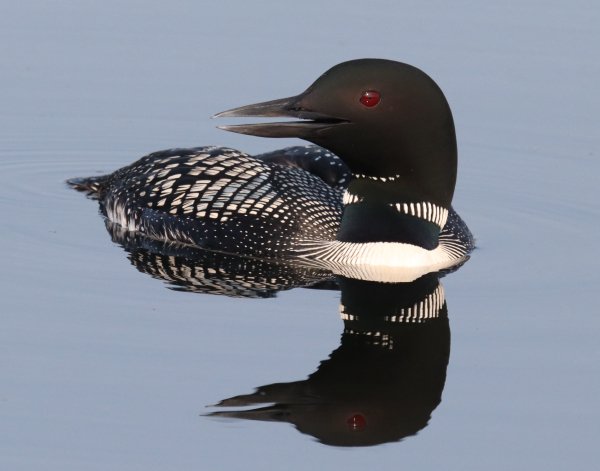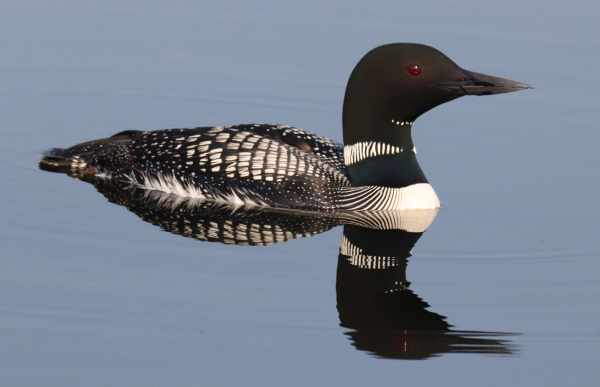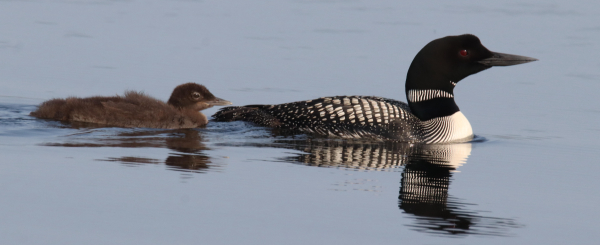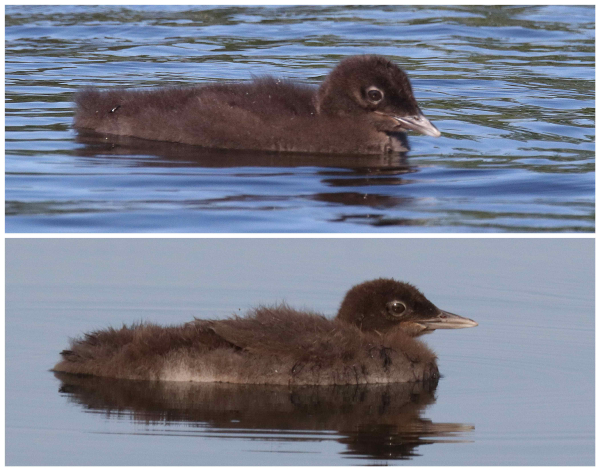Summer naturally draws my attention to the lakes country of Minnesota, with Detroit Lakes as the hub, just an hour east of Fargo. But during the hour-long drive, the landscape transforms from the Great Plains to the woodland and lakes country at the western edge of the eastern woodlands. It’s also the western edge of the range of Common Loons in this region, and these days the loons are a real attraction. As I’ve pursued loons photographically the past 3 years, I’ve made a few loon-fan converts – longtime friends who enjoy the activity of photographing adult loons, and family groups.

During the 3 most recent summers, Andy has been the catalyst with his pontoon boat, which I refer to as the “luxury loon pontoon;” and Andy has become an ace bird photography boat caption. Dwight, who visits from Portland, Oregon, has been the most common addition to the loon photo cruises, and he was along for last Thursday morning’s photo session. Linda, from Hollywood, California, is our other regular loon cruise fan and Linda was on hand with Andy and me 10 days earlier, on June 30th.
Our initial loon expedition was to see if any young loons had hatched by the first of July, and as I drove to Andy’s lake, I thought we might be a bit too early to find recent hatchlings. Considering what we learned the previous 2 summers, when we found an incubating pair in mid-June the first summer, and 2 pairs with hatchlings July 14th last summer, I was hoping to find some recent hatchlings with a pair to try to get some photos of a hatchling or 2 riding on the back of an adult. Being familiar with Western Grebes and the fact that hatchlings ride on the back of the adults for a month or longer after hatching, I expected a similarly long back-riding period for loons, but that’s not the case.

When the 7- and 10-day-old Common Loons that we found last July didn’t ride on the adults’ back, I researched the behavior a little more and found out that young loons only ride on the adults’ back during the first week after hatching, so it turned out we were late last year. As we talked about it during the next loon photo cruise, we figured the first week of July should be the best bet, with July 4th as the prime date. But knowing boat traffic might be heavy around the 4th, I opted for a beautiful sunny afternoon with a light wind a few hours before July 1st, and Andy was up for the plan, as was Linda, who has a lake house nearby that she favors during summer months.
When I arrived in time for our 5pm excursion, I explained that we might be early, but I took a quick look at the areas of the lake that I could see from Andy’s shore, and saw what I thought was a pair of loons with at least 1 hatchling – Hooray! As we were getting on board the pontoon, I literally felt like a little kid, giddy with the excitement of what was to come. Andy took a pretty direct route to the loons, and as we approached we could see there was a single downy hatchling, about 5 days old I figured. It was a thrill for all of us to be back on the lake with loons in sight, appreciating the beauty of the family group together; watching the adults diving for fish, feeding tiny fish to the hatchling, with the adults swallowing larger fish for themselves – including an especially large sunfish.
Andy and I were surprised at the “early” arrival of the downy hatchling, but especially by the “advanced” age of the young loon. It still had its dark brown natal down, but it didn’t climb on the back of either adult, nor did it make any attempt to do that. Was it inhibited by our presence? It would seem it might climb aboard as a form of protection if for no other reason, but then again, we were not close enough to concern the loons in the least, so the hatchling may just have been beyond the age of back riding. Or maybe back riding among loons just isn’t as common as we imagined.

Essentially, waterbirds like loons and grebes use back riding as a way to help keep newly hatched young warm during the initial days after hatching, while the hatchlings develop homeostasis that allows them to thermo-regulate their own body temperature, which takes a couple days. After those initial days, grebes continue to ride on the back, but loons do not, and it may be that loons don’t prolong the back riding behavior beyond those couple initial days.
We did search for other loon families, but only found 2 pairs of adult Common Loons, which suggested they either did not nest, or were unsuccessful in their nesting attempt this year. Well, maybe next year we can find back-riding hatchlings; it’s a great reason to look for newly hatched loons a little earlier next year. Just being on the water is a remarkable release, and to be in the company of loons and other wildlife and sharing the experience among friends is a true joy.

Chapter 2
Having photo-documented the development of young loons from downy hatchlings to feathered fledglings last year, and being on the lake with Linda and Andy early the week before, I wouldn’t have returned to the loon kingdom so quickly, but suddenly Dwight was on his way from Portland, so the plan was to meet at Andy’s lake home last Wednesday evening, then hop on the ‘luxury loon pontoon’ Thursday morn. At sunset Wednesday the lake was like glass, and loons were calling in the distance, setting the stage for another photo session on the water.
The water remained calm and glassy at 8am, and I located a loon through binoculars from Andy’s elevated deck. Having taken initial photos of the family of loons in that area recently, I was a bit more relaxed at the start of this cruise, but Andy and Dwight showed more enthusiasm than usual so it all balanced out. As we approached the floating adult loon’s position, I spied the downy hatchling nestled in the midst of an open stand of low emerging bulrushes. Andy edged the pontoon into the shallows with the morning sun at our back and turned the low-murmur of motor off. The level of quiet was amazing, and when coupled with the glassy water on which the adult and downy hatchling floated without a movement or a ripple, these were moments to absorb and remember. Aah, breathe in that morning air.

Of course, I was photographing already, and the occasional click of the camera shutter was the only sound, aside from the call of an occasional Belted Kingfisher, or Red-winged Blackbird. These moments were priceless, as were the resulting photographs in the beautiful light that couldn’t have been better. We enjoyed the ambiance and being in the company of the loons, but after a time we were ready to leave them to their morning repose. But just as Andy was about to start the motor, the downy loon swam toward the adult, and the 2 floated in sync a few moments before edging away from the vegetation that bordered the shoreline.
As they progressed across the open water, Andy paralleled them for a moment, then shut the motor down again as I photographed the adult and downy together. I said something to the effect of “this is what being immersed with nature is all about,” and as if in response the adult loon raised its head and shared its wild loon call, the call of the North Woods lakes. Dwight suggested the loon shared the sentiment, and we left the loons to their morning activities.

Andy wanted to give Dwight a look at the larger adjoining lake, which would also give us a chance to search for other loons and wildlife along the northeast and southeast shorelines. In addition to seeing more adult loons, a couple Bald Eagles and Ospreys, as we were exiting the bigger lake, Andy spied a female Common Merganser with a newly hatched duckling. Suddenly an assemblage of ducklings literally popped into view from below water, one at a time, until 21 merganser ducklings surrounded the female. It was a funny and memorable observation, and Andy eased to a vantage point that provided a better lighting angle, and the ducklings resumed diving under water and re-popping into view – pop-pop-pop-pop-pop! Tooo Koool.
Andy, Linda, Dwight, and I hope you enjoy the selection of Common Loon photos I took during our early summer lake voyages. The technical side of the photos was very simple because we had uniformly blue sky weather with barely a ripple on the water and beautiful sunlight. I used my usual ISO 800 setting, an aperture that provided wide areas within focus, especially when more than one bird was in the focal area (f-8 to f-13). The resulting shutter speeds ranged from 1/1250 to 1/800. These loon photo sessions have become an especially fun time to share among friends in a beautiful landscape of clear water and woodlands colored in a variety of shades of green. What fun we shared among friends.
Article and Photographs by Paul Konrad
Share your bird photos and birding experiences at editorstbw2@gmail.com
